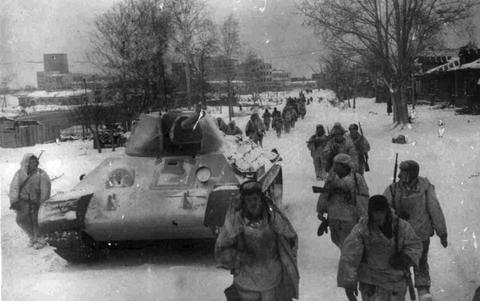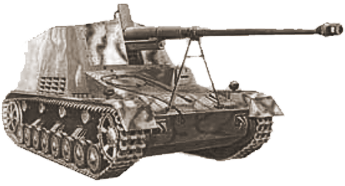The Red Army's January 1942 Offensive

Early in December 1941 German led Axis forces had driven to the gates of Moscow. However, the Red Army counter-attacked their overextended enemy. Soviet armies drove the Wehrmacht and its Axis allies back across the entirety of the front, and put the nail in Operation Barbarossa's coffin. Nevertheless, by early in January 1942 most of the initial Soviet counterstrokes had fizzled to a halt, and for good reason.
In just over six months of warfare the Soviet Union had lost control over 40 percent of its population, a third of its heavy industry, and staggering military losses reaching nearly 5 million men, 20,500 tanks, 101,100 guns and mortars, and 17,900 aircraft; representing 229 divisional size units wiped from the Red Army’s order of battles. Other leaders likely would have sought to dig in after having won some hard fought breathing space. Not Josef Stalin. He aggressively authorized another offensive. The Red Army however lacked striking power in spite of fielding 43 armies and 4.2 million men. The December counterattacks near Moscow had shattered the best of the Soviet reserves. The Red Army of January 1942 was a far cry from the sophisticated mechanized practitioner of Deep Operations it would become by 1943. Consequently Soviet architect of the December counter-offensive, Georgy Konstantinovich Zhukov, initially approved of a more concentrated attack on Army Group Center, as Zhukov feared his forces lacked enough strength to achieve broad results. Events would prove Zhukov’s analysis correct. He nonetheless gradually adjusted his position to one more in line with Stalin’s more expansive goals. Zhukov finally agreed that multiple offensives across the front’s breadth could pay substantial dividends if at least destroying some German armies.
Stalin launched his massive thousand mile front wide offensive on January 7, 1942. Nine Front’s led the campaign running from north to south as follows; Leningrad Front led by Khozin, Volkhov Front led by Meretskov, Northwestern Front led by Kurochkin, Kalinin Front led by Konev, Western Front led by Zhukov, Briansk Front led by Cherevichenko, Southwestern Front led by Timoshenko, Southern Front led by Malinovskii, and finally the Caucasus Front led by Kozlov.
In the Eastern Ukraine Army Group South’s 6th and 17th Armies were hammered by the Soviet 6th, 9th, and 57th Armies in an offensive beginning on January 18, 1942. By the 21st the Red Army had broken the German front in two locations near Izyum. By January 23rd Soviet forces had blown open a 50 mile breach in German defensive positions on the Donets River. Unfortunately, for the Red Army, even as its shock armies penetrated into the German operational rear, they lacked the logistical support, mobility, and reserves to really do anything with their success. The 1st Panzer Army led the German counterattacks and battered the Soviet attackers back into what became a bulge in the German lines near Izyum. By early March the front had largely stabilized. Meanwhile, Manstein’s 11th Army in the Crimea also fought a desperate struggle during the early part of 1942, battling against amphibious landings not only near Feodosiya and Kerch but also near Eupatoria north of Sevestapol in a Soviet operation launched on January 5, 1942. Manstein defeated the Eupatoria landing, and for the most part confined Soviet gains to the Kerch peninsula denying the Red Army her sought after link up with Sevastopol’s embattled defenders.
Further north, Konev’s Kalinin Front wreaked havoc along the German front as the Soviet 4th Shock Army, 29th Army, and 39th Army drove far behind Army Group Center’s front lines. On January 5th the 3rd Shock Army split Reinhardt’s Third Panzer Army from Ninth Army’s VI Corps at Rzhev. Hitler allowed the bulk of Army Group Center to withdraw on January 15th though inexplicably Kluge was tardy in relaying the order. But Hitler had also demanded Rzhev held and Ninth Army, now under General Walter Model, successfully checked the Russian advance on January 21st. At the same time Belov’s 1st Guards Cavalry Corps, supported by the airdropped 4th Airborne Corps’ three brigades as well as partisans, roamed behind the Third and Fourth Panzer Army’s creating further chaos across a front that had dissolved in any meaningful sense. For instance neither Army Group North’s Sixteenth Army nor Army Group Center’s Third Panzer Army held a front line. Instead, Third Panzer Army’s divisions fought in hedgehog defensive positions mostly centered on the towns of Velikie Luki, Velizh and Demidov linked with each other by screening forces. Just to the north Sixteenth Army’s southernmost defensive position centered on the town of Kholm, but an epic struggle played our near Demyansk.
In the snow blanketed forests and fields near Demyansk, Kurochkin’s Northwestern Front had surrounded 70,000 German soldiers from Colonel General Ernst Busch's 16th Army. Down to only 11 divisions by late in December 1941 those men represented a significant chunk of the German 16th Army. Though surrounded in a 35-mile wide kessel Busch's men held out for the remainder of the winter, led by the efforts of the murderous Totenkopf SS Motorized Division which fought maniacally in defending the pocket, before relief arrived in April. The relief effort led by Lieutenant General Walter von Seydlitz-Kurzbach actually lasted from March 20th to April 21st. It featured a specialized force of five divisions that included two veteran reinforced Jaeger divisions. The Jaegers, German light infantry, normally worked as specialists in mountain warfare, but increasingly provided the model for the lean German infantry formations filling out the eastern army.
Although Seydlitz’ men successfully reestablished contact with the surrounded soldiers, the encircled men had lasted until relieved primarily through aid provided by Luftwaffe supply drops. The ability of such a large force to hang on when surrounded created an unfortunate precedent in Hitler’s mind. Hitler regarded the survival of the army near Demyansk as predictive of future events; even normative. Hitler’s conclusions from Demyansk exacerbated the need for German units to hold dangerous salients and isolated pockets of resistance time and again in the future. Incredibly German forces never evacuated the pocket completely, and the battles around Demyansk dragged on for a full year. As it was the Luftwaffe lost over 265 Ju-52 transport aircraft over Demyansk; destroying the cream of the German air transport arm.
Long before events near Demyansk finished playing out however, and by February 1942, the Soviet offensives had ran out of steam. Both the punch drunk Wehrmacht and Red Army staggered to replenish and refresh their forces for the pivotal summer campaign season to come.
Recommended secondary sources for readers further interested in this important period during the Second World War:
Rodric Braithwaite, Moscow 1941 A City and Its People At War, (Alfred A. Knopf, 2006)
David M. Glantz, Barbarossa, Hitler’s Invasion of Russia 1941, (Tempus Publishing Inc. 2001)
David M. Glantz, Stumbling Colossus, The Red Army on the Eve of World War, (University Press of Kansas, 1998)
David M. Glantz, The Soviet-German War 1941-1945: Myths and Realities: A Survey Essay, A Paper Presented as the 20th Anniversary Distinguished Lecture at the Strom Thurmond Institute of Government and Public Affairs Clemson University, October 11, 2001 (Clemson, South Carolina)
John Erickson, The Road to Stalingrad, (Harper & Row Publishers, 1975)
Robert Kershaw, War Without Garlands, Operation Barbarossa 1941-1942, (Ian Allen, 2000)
Evan Mawdsley, Thunder in the East, The Nazi-Soviet War 1941-1945, (Hodder Headline Group, 2005)
Steven Mercatante, Why Germany Nearly Won: A New History of the Second World War in Europe,(Praeger, 2012)
Milatargeschichtliches Forshungsamt, Germany and the Second World War, Volume IV The Attack on the Soviet Union, (Clarendon Press, 1998)



Post new comment